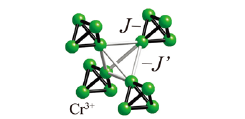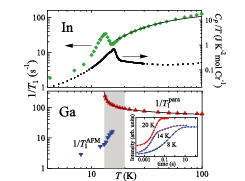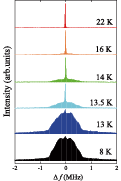Novel Phase Transitions in the Breathing Pyrochlore Lattice:7Li-NMR on LiInCr4O8 and LiGaCr4O8
Takigawa and Hiroi Group
Antiferromagnetically coupled spins on the pyrochlore lattice, a three dimensional network of corner sharing tetrahedra, are expected to show exotic magnetic properties due to strong geometrical frustration. The Cr spinel oxides ACr2O4 (A = Mg, Zn, Cd etc.) are well-known examples, where Cr3+ with spin 3/2 form a pyrochlore lattice. Recently, Okamoto et al.[1] studied a new type of Cr oxides LiInCr4O8 and LiGaCr4O8, where Li+ and In3+/Ga3+ ions alternately occupy the A site of ACr2O4, allowing Cr spins to form a breathing pyrochlore lattice with alternation of large and small tetrahedra and two distinct exchange coupling J and J’ (J > J’) (see Fig. 1). Here we report on novel phase transitions observed by 7Li-NMR in LiInCr4O8 and LiGaCr4O8, for which the breathing factor Bf=J’/J is estimated to be 0.1 and 0.6, respectively [2].

Fig. 1. The structure of the breathing pyrochlore lattice.

Fig. 2. Upper panel: Temperature dependences of 1/T1 (this work) and the specific heat divided by temperature (taken from [1]) in LiInCr4O8. The line shows an activation law with a spin gap of 31 K. Lower panel: Temperature dependences of 1/T1 of the paramagnetic (red) and antiferromagnetic (blue) components in LiGaCr4O8. The shaded area represents the temperature range, where the NMR spectra in Fig. 3 indicate coexistence of two phases. The solid line shows a fit to a power law divergence towards 13 K. The inset shows the recovery curves at different temperatures. The data at 14 K can be fit to a sum of two components.

Fig. 3. Temperature dependence of the NMR spectra in LiGaCr4O8. The vertical scale is normalized by the peak intensity. The origin of the horizontal axis corresponds to the center of gravity.

Fig. 4. Schematic phase diagram for LiGaCr4O8. On the vertical axis, α represents a phenomenological tuning parameter of the Hamiltonian. The region Δα shows the distribution of α in our sample. The dashed and solid double lines indicate first- and second-order transitions, respectively, which are separated by a tricritical point indicated by the open circle.
As shown in the upper panel of Fig. 2, the nuclear spin relaxation rate (1/T1) in LiInCr4O8 shows activated temperature dependence down to 18 K, indicating a singlet ground state with a spin gap of 31 K. This behavior, however, is disrupted by double phase transitions, one corresponding to the peak at 13 K in 1/T1 and another to the peak at 16 K in the specific heat. The former indicates a second order antiferromagnetic (AF) transition with critical slowing down. The AF order is also confirmed by the broadening of NMR spectrum. The latter peak in the specific heat most likely corresponds to a structural transition, which lowers the symmetry of the lattice and thereby relieves the frustration, enabling the AF order at a lower temperature.
The behavior in LiGaCr4O8 is quite different. As shown in Fig. 3, a broad NMR spectrum develops below 16 K under a sharp peak that persists down to 13.5 K, indicating coexistence of the paramagnetic and AF ordered phases. Furthermore, the width of the broad spectrum does not depend on temperature, meaning that the magnitude of AF moments is constant once the transition has occurred. Therefore, AF transition must be first order. The results of 1/T1 in the lower panel of Fig. 2 also support coexistence of two phases. Surprisingly, 1/T1 of the paramagnetic component shows divergence toward 13 K as if there were second order AF transition. This transition, however, is not realized because the intensity (volume fraction) of the paramagnetic component vanishes near 13 K. These observations suggest that LiGaCr4O8 is located near a tricritical point in the phase diagram that separate first- and second-order transition lines as shown in Fig. 4.
The contrasting behavior of the two compounds demonstrates that breathing pyrochlore materials provide unique opportunities to tune the degree of frustration in a controlled manner.
References
- [1] Y. Okamoto, G. J. Nilsen, J. P. Attfield, and Z. Hiroi, Phys. Rev. Lett. 110, 097203 (2013).
- [2] Y. Tanaka, M. Yoshida, M. Takigawa, Y. Okamoto, and Z. Hiroi, Phys. Rev. Lett. 113, 227204 (2014).
